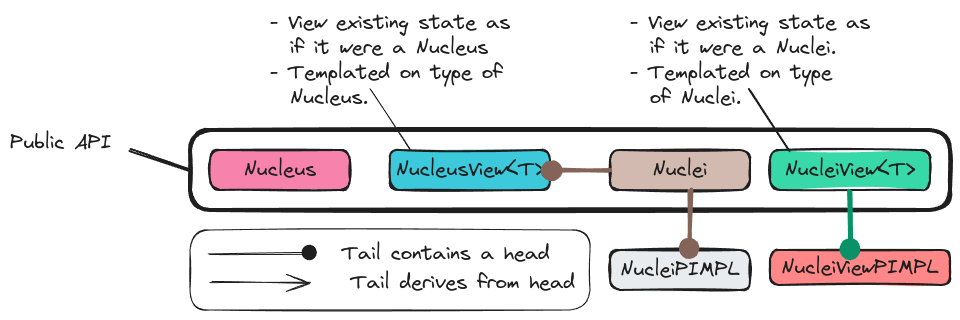Designing the Nucleus Component
This section contains notes on the design of Chemist’s nucleus component.
What is the Nucleus Component?
In the present context a nucleus is the core of an atom and is comprised of neutrons and protons. The nucleus component contains the abstractions needed to represent a single nucleus as well as a set of nuclei.
Why do we need a Nucleus Component?
Anecdotally most quantum chemistry packages do not bother with classes for
describing the nucleus, so why should we? There’s a couple reasons. First,
particularly when it comes to manipulating the chemical system we often treat
the nuclei independent of the electrons (i.e. we invoke the Born-Oppenheimer
approximation). Having separate classes for the nuclei and the electrons makes
this easier as we have literal different objects we can manipulate. Second,
while the nuclei are often treated as point charges, they need not be. High
accuracy work may take into account the finite size of the nucleus and even its
quantum mechanical nature. These different descriptions
require different parameters (and therefore different classes). Our final
motivation for having a separate Nucleus class is that when it comes time
to take derivatives or define operators with respect to particles we can use
the Nucleus and Nuclei classes in the types of the derivative/operator
thus obtaining separate types for taking derivatives with respect to nuclei vs
electrons (and different operators).
Nucleus Considerations
- basic parameters
Nuclei are assumed to be centered on a point, have a mass, an atomic number, an overall charge, and an atomic symbol.
- atomic number vs. charge
In atomic units the atomic number of a nucleus is the same as the charge. As such it is reasonable to not distinguish among the two; however, there are a couple reasons to separate them:
As alluded to, the two are only equal in atomic units. We intend to add unit support at a later time.
The atomic number is always an integer and is often used as the key in maps. While the charge is an integer in atomic units, it is still often used in mathematical contexts where it needs to be a floating point type. While integers and floating-poing values can be converted somewhat easily, having separate functions helps avoid compiler warnings.
- Views
Traditionally the molecular system has been stored as a structure of arrays. This is primarily for performance reasons. From a user-perspective an array of structures is easier to use. By introducing views we can have both. The view objects act like the values, but only alias their state.
We need views of
Nucleusto be used as references into theNucleicontainer.We need views of
Nucleito be used in containers likeFragmentedNucleiwhere the elements are meant to beNucleiobjects.Views also enable external libraries to wrap their data in an API compatible with Chemist.
Out of Scope
- non-point charge like nuclei
While we recognize that nuclei need not always be treated as point charges, given how often they are treated as point charges, we are focusing on point charge-like nuclei only for right now. Additional classes can be added to the hierarchy to handle more realistic approximations.
Nucleus Design

Fig. 4 Classes comprising the Nucleus component of Chemist.
The classes of the Nucleus component are shown in Fig. 4. The figure divides the classes into two categories those which are part of the public API and those which are needed to implement the public API. The following subsections contain more details about the various classes.
Nucleus/NucleusView
The Nucleus class is the fundamental class of the hierarchy. Consistent with
the basic parameters consideration it will derive from PointCharge.
On top of PointCharge’s state we add the mass, atomic number, and atomic
symbol. The NucleusView class, consistent with Views allows users
to wrap existing data in objects and have those objects be used as if they are
Nucleus objects.
Nuclei/NucleiView

Fig. 5 Class hierarchy implementing NucleiView.
Generally speaking we do not usually deal with a single nucleus, we deal with a
set of nuclei. The Nuclei object serves as a container for Nucleus
objects. A separate class, versus say an STL container, is needed because
internally the Nuclei object will usually unpack the data found in the
Nucleus objects it contains. This is for performance (vectorization
specifically). The NucleusView class then serves a convenient mechanism for
the Nuclei class to alias the unpacked state, while maintaining the
Nucleus API.
Similar to NucleusView, NucleiView is designed to facilitate using
existing data as if it were a Nuclei object. In practice, there are a lot
of different ways to bring together a set of nuclei and NucleiView will need
optimized backends for each scenario. These implementations are summarized in
Class hierarchy implementing NucleiView. and include:
ContiguousNucleiView. This is the “traditional” implementation found in most quantum chemistry codes. You have one array per property such that the \(i\)-th element of the array is the value of that property for the \(i\)-th nucleus (properties here include the accessible state of aNucleusclass).NucleiSubset. Many approximations partition the system of interest into subsets. This backend stores a view of the nuclei from the system of interest, i.e., a view of the supersystem, and the members of the superset that are in the subset. With the superset view present, offsets for the subset members suffices.NucleusViewList. Sometimes you just have a bunch ofNucleusViewobjects you want to treat as the elements of aNucleiView. This PIMPL holds a vector ofNucleusViewobjects.NucleiUnion. A functional inverse ofNucleiSubset. When you have pieces of a system you often want to combine them. While it’s always possible to useNucleusViewListfor this purpose, it’s often just easier to store a vector ofNucleiViewobjects.
Summary
- basic parameters
The
Nucleusclass contains the specified parameters.- atomic number vs. charge
The
Nucleusobject stores the atomic number as separate state. By default the charge is set to the atomic number (and the units are assumed to be atomic units).- Views
The
Nucleus, andNucleiclasses are paired withNucleusViewandNucleiView.